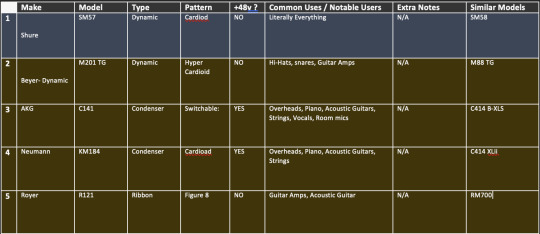Text
The Good, The Bad, And Next time
During this assessment I believe multiple parts are good, on being the drums I played for this song, I feel the y are consistent and provided all that they needed too with in the song as a whole and the end result of the song was good too I believe.
However I feel the mixing was very minimal and not very good because I didn't understand a lot of what I was doing for the mixing, I feel as though all I managed to do was the basics of adding small eq changes and reverb.
For next time i'm going to give myself more time to focus more on the mixing area of the work as it would help me improve as well as help me to be able to mix my own music for when I wish to release it.
0 notes
Text
Mixing With The DAW
I attempted to use Pro Tools for my mixing as I thought it would be useful to understand it all earlier rather than later on in the module. I began with the drums I added reverb to the drums to add to the fullness of the track, it made the track sound more bright as I also used EQ to highlight areas of each sections of the kit, for instance I made the snare have more mid and high mid frequencies so the snare would sound more impactful as well as that I increased the input and outputs to it would be louder because I believed it was a bit buried in the mix of the other instruments. I did the same with the kick drum, Acoustic guitars, and also the melodic bass line however I didn’t do it too heavily as I didn’t want an overpowering amount of change due to the sound having to drastic of a change making the mix sound messy. The melodic bass also contained a room reverb as it added to its tone making it sound more full amongst the other instruments. The research and help I did for this was a course-mate who understood a lot more about mixing and recommended different options I could take while mixing, his name was Ben Springall.
0 notes
Text
Isn’t She Lovely - Drums
The studio recording I have taken part in creating is a cover of the song “Isn’t She Lovely” by Stevie Wonder. For the recording I played the drums for it, we used a 5 microphone set up. Because of the previous research and recommendations we chose to use two C414 XLS for the overheads, they worth both on a wide cardioid pattern so they would be able to capture the whole range of the drum kit with each of them.
Another microphone we used was for the snare drum and it was the Audix i5 which apparently “Provides clear sound reproduction without having to rely on EQ” according to “AudixUSA” themselves which means we had a clear natural sound from the snare microphone. The response of the i5 is between 50hz and 16 khz which is well with in the snares frequency range of 900hz - 2khz so it captured a good clear sound from the snare drum.
The kick drum had another microphone by the Audix company and it was the Audix D6. The Audix D6 was a good choice for a kick drum microphone, it says within the “AudixUSA” website how it is “an excellent choice for miking instruments requiring extended low-frequency reproduction such as kick drums.” I believed it provided a good kick tone in my opinion which wasn’t too overpowering to everything else.
And finally we used a Neumann to get the ambience of the room while the drums were playing for a small addition to the mix of the drums and the whole song. We set up a plastic board, between the drums and the microphone, to block out all the direct sounds to the microphone from the drum kit and we set the Neumann microphone to Omni directional, This made it easier to gather more of the reflected ambient sounds of the drums while they were being played instead of getting louder direct sounds if the board wasn’t there.
AudixUSA (2022). i5. [online] Audix. Available at: https://audixusa.com/products/i5/.
AudixUSA (2022a). D6. [online] Audix. Available at: https://audixusa.com/products/d6/.
0 notes
Text
Microphone Recommendations For Others
Using the previous knowledge of microphones and what I have learnt recently I assisted fellow music students in recommending microphones for their project. I recommended they used the Neumann for their vocal due to research i have done and tested before. We applied a pop shield to the microphone to reduce sibilance from the vocal, this gets rid of any unwanted sound from the vocal including the forceful airy "p" sound of words.
I also recommended that other people used a couple of condenser microphones for an acoustic guitar recording. I said to possibly use a set of C414 XLS for it and i used the same microphone set up as the acoustic guitar I did previously for Stefan, one further away from the other. The C414 XLS "Offer enormous value and studio grade quality." (Kaksal C, 2021) which is a good reason to use them as you will get the good quality you would want in a recording.
Koksal, C. (2021). AKG C414 XLS vs XLII? Well, depends! ([month_year]). [online] Soundton. Available at: https://www.soundton.com/akg-c414-xls-vs-xlii/ [Accessed 27 May 2022].
0 notes
Text
Stefan Technical Assistance And Research Pt.2
We also used two KM184 microphones on an acoustic guitar. We pointed on towards the bridge of the guitar and one at the 12th fret of the guitar. We positioned one microphone further away behind the other to change the sound and lessen the impact of the volume due to the microphone being nearer to the sound hole of the guitar. We decided use them as they have a wide range of instrumental usages, including classical piano and heavy metal drums (Neumann, 2012) it is also said to be a "Worldwide stage and studio standard microphone for many applications." (Neumann 2012)
NEUMANN (2012a). KM 184. [online] en-de.neumann.com. Available at: https://en-de.neumann.com/km-184#description.
0 notes
Text
Stefan Technical Assistance and Research
We used the Neumann for vocals, “the most wildly used studio microphone.” (Neumann 2012). We used the Neumann because we believed it was a trustworthy and good sounding microphone, due to lecture 5 where we discussed and tested out different vocal microphones. The frequency response of Neumann is very good as we found out, its frequency response ranges from 20hz to 20,000hz. We also used a pop shield which was good as the time as I had an issue with my mouth and had a slight lisp meaning the microphone would be picking up very heavy hissing sounds do to the unintentional yet used “s” sounds I had to say. I will be using this microphone in future recordings due to my experiences.

NEUMANN (2012b). U 87 Ai Studio Set. [online] Neumann.com. Available at: https://en-de.neumann.com/u-87-ai.
0 notes
Video
here is the video of our final assessed performance for the first year of the songwriting and performance module
0 notes
Audio
This is a short recording of a very minimal song, in it we used the low tom of a drum kit, a synth with one note and one string on a guitar reaching up for other notes
0 notes
Video
1 minute song from acapella hooks, using acoustic guitar and vocals
0 notes


